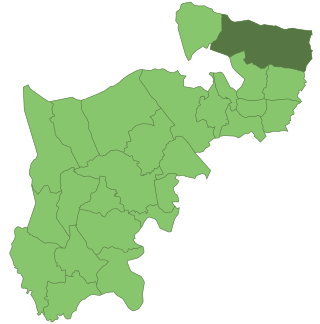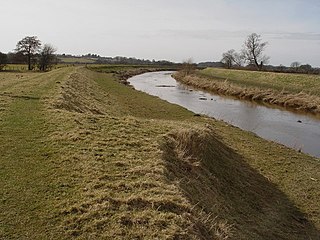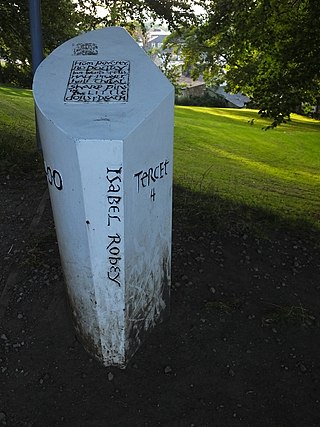See also
- Armorial of UK universities
- Red Rose of Lancaster, the county flower of Lancashire
- Duchy of Lancaster
The coat of arms of Lancaster University is the official emblem of Lancaster University, in Lancashire, England. It was granted to the university by Royal Charter on its establishment in 1964.
The coat of arms has several heraldic elements. [1] Centrally positioned, a horizontal, wavy blue line refers to the River Lune, a prominent geographic landmark of the city of Lancaster. Secondly, the two red roses are symbols of the House of Lancaster (and the county of Lancashire) and are taken directly from the arms of the Lancashire County Council. The open book represents wisdom and the university's purpose as an institution of learning. Lastly, the Lion passant comes from the arms of the Duchy of Lancaster. [1]
The arms, slightly modified, may be seen on the university's logo. The full coat of arms also appears on degree certificates and the jerseys of the university's sports teams.
The complete blazon is the arms surrounded by a 'coat'; the full coat of arms. In addition to the arms, the insignia contains quilled pens which refer to the learned activities of the university and the rams head, from which the pens protrude, comes from the county of Westmorland. The supporting bull comes from the arms of Cumberland Council and the dragon represents the ancient Cumbria. Finally, the flower comes from the arms of the council and the Fleurs de Lis is from the arms of the City of Lancaster. [2]
Lancaster University's motto is a component of the coat of arms; taken from a medical pamphlet called Famosa Apologia, which dates from around the early seventeenth century. [2]
Translated from Latin, the phrase "Patet omnibus veritas" means "truth lies open to all". There is also a longer translation:
Those who were before us are not our masters but our leaders. Truth lies open to all. It is not yet anyone's possession. Much of it is left, even for those to come. Nothing, indeed, is more hostile to truth than to take away freedom of speculation. [2]

Lancashire is a ceremonial county in North West England. It is bordered by Cumbria to the north, North Yorkshire and West Yorkshire to the east, Greater Manchester and Merseyside to the south, and the Irish Sea to the west. The largest settlement is Blackpool, and the county town is the city of Preston.

Lancaster is a city in Lancashire, England and the main cultural hub, economic and commercial centre of City of Lancaster district. The city is on the River Lune and is directly inland from Morecambe Bay. Lancaster was the county town of Lancashire until the county council's administrative headquarters moved to Preston in 1974.

Ulverston is a market town and civil parish in Westmorland and Furness, Cumbria, England. In the 2001 census the parish had a population of 11,524, increasing at the 2011 census to 11,678. Historically in Lancashire, it lies a few miles south of the Lake District National Park and just north-west of Morecambe Bay, within the Furness Peninsula. Lancaster is 39 miles (63 km) to the east, Barrow-in-Furness 10 miles (16 km) to the south-west and Kendal 25 miles (40 km) to the north-east.

Lancaster Castle is a medieval castle and former prison in Lancaster in the English county of Lancashire. Its early history is unclear, but it may have been founded in the 11th century on the site of a Roman fort overlooking a crossing of the River Lune. In 1164 the Honour of Lancaster, including the castle, came under royal control. In 1322 and 1389 the Scots invaded England, progressing as far as Lancaster and damaging the castle. It was not to see military action again until the English Civil War. The castle was first used as a prison in 1196 although this aspect became more important during the English Civil War. The castle buildings are owned by the British sovereign as Duke of Lancaster; part of the structure is used to host sittings of the Crown Court.

The coat of arms of Prince Edward Island, officially the King's Arms in Right of Prince Edward Island, are the coat of arms of Prince Edward Island, being the arms of King Charles III in right of the province. They were created when the shield and motto in the achievement were granted in 1905 by royal warrant from King Edward VII. The latest iteration was given by the Canadian Heraldic Authority in 2002.

The White Rose of York is a white heraldic rose which was adopted in the 14th century as a heraldic badge of the royal House of York. In modern times, it is used more broadly as a symbol of Yorkshire.

The coat of arms of Finland is a crowned lion on a red field, the right foreleg replaced with an armoured human arm brandishing a sword, trampling on a sabre with the hindpaws. The coat of arms was originally created around the year 1580.

The Red Rose of Lancaster was the heraldic badge adopted by the royal House of Lancaster in the 14th century. In modern times it symbolises the county of Lancashire. The exact species or cultivar which it represents is thought to be Rosa gallica officinalis.

The Tudor rose is the traditional floral heraldic emblem of England and takes its name and origins from the House of Tudor, which united the House of Lancaster and the House of York. The Tudor rose consists of five white inner petals, representing the House of York, and five red outer petals to represent the House of Lancaster.

Fylde College is a constituent college of the University of Lancaster, in Lancashire, England. The college was the sixth of the university’s colleges. Construction of the college buildings began in 1968 and the college began accepting students in 1969. The College officially opened in 1971. The college is named after the Fylde area of Lancashire.

The Coat of arms of the Republic of Latvia was officially adopted by the Constitutional Assembly of Latvia on 15 June 1921, and entered official use starting on 19 August 1921. It was created using new national symbols, as well as elements of the coats of arms of Polish and Swedish Livonia and of the Duchy of Courland and Semigallia. Thus, the coat of arms combines symbols of Latvian national statehood, as well as symbols of its historical regions. The Latvian national coat of arms was designed by Latvian artists Vilhelms Krūmiņš and Rihards Zariņš.

The first coat of arms of Montreal was designed by Jacques Viger, the first mayor of Montreal, and adopted in 1833 by the city councillors. Modifications were made some one hundred five years later and adopted on 21 March 1938, and again on 13 September 2017, resulting in the version currently in use. The coat of arms was the only city emblem representing Montreal until 1981, when a stylized logo was developed for common daily use, reserving the coat of arms for ceremonial occasions.

Enfield was a local government district in Middlesex, England from 1850 to 1965.

The rose is a common device in heraldry. It is often used both as a charge on a coat of arms and by itself as an heraldic badge. The heraldic rose has a stylized form consisting of five symmetrical lobes, five barbs, and a circular seed. The rose is one of the most common plant symbols in heraldry, together with the lily, which also has a stylistic representation in the fleur-de-lis.

Winmarleigh is a village and civil parish of the Borough of Wyre in Lancashire, England. The population taken at the 2011 census was 273. The village, which is north-west of Garstang, has an agricultural college, and the Duchy of Lancaster has an estate here. This includes the local pub, the Patten Arms. It is home to the great manor of Winmarleigh Hall. Constructed to the order of the Duchy of Lancaster, it was given to the first Lord Winmarleigh. Since then the house has been donated to NST Travel Group, who have turned the grounds into an outdoor education programme for schools across the country.

The coat of arms of Wigan Metropolitan Borough Council was granted by the College of Arms in 1974.

Great Eccleston is a village and civil parish in Lancashire, England situated on a coastal plain called the Fylde. The village lies to the south of the River Wyre and the A586 road, approximately 10 miles (16 km) upstream from Fleetwood. At the 2001 census, the parish had a population of 1,473, rising slightly to 1,486 at the 2011 census.

The City of Manchester in North West England has traditionally been represented by various symbols. Most of these symbols are derived from heraldic emblems contained within the city's official heraldic achievement, which was officially adopted when the Borough of Manchester was granted city status in 1842. Notably, the motif of the worker bee has been widely used to represent the city as a symbol of industry.

The coat of arms of the London Borough of Enfield is the official heraldic arms of the London Borough of Enfield, granted on 15 August 1966.

The Lancashire Witches Walk is a 51-mile (82 km) long-distance footpath opened in 2012, between Barrowford and Lancaster, all in Lancashire, England. It starts at Pendle Heritage Centre in Barrowford before passing through the Forest of Pendle, the town of Clitheroe and the Forest of Bowland to finish at Lancaster Castle.